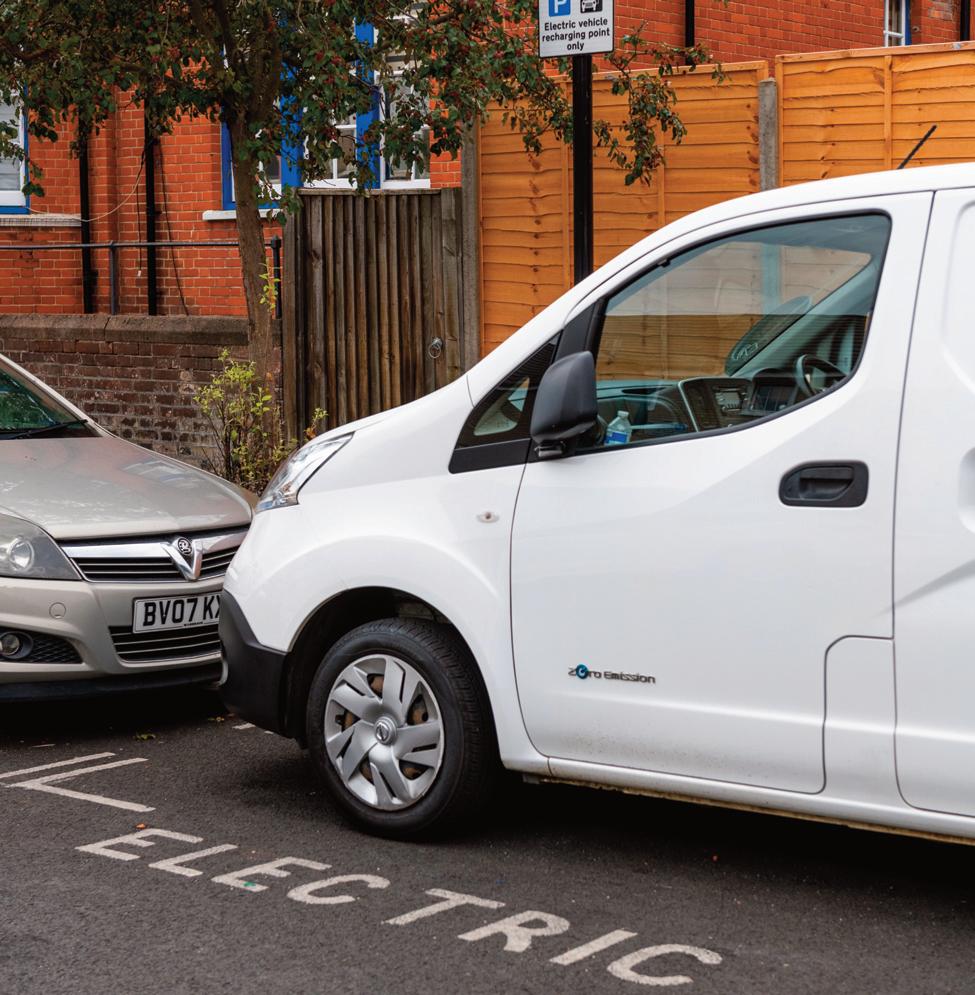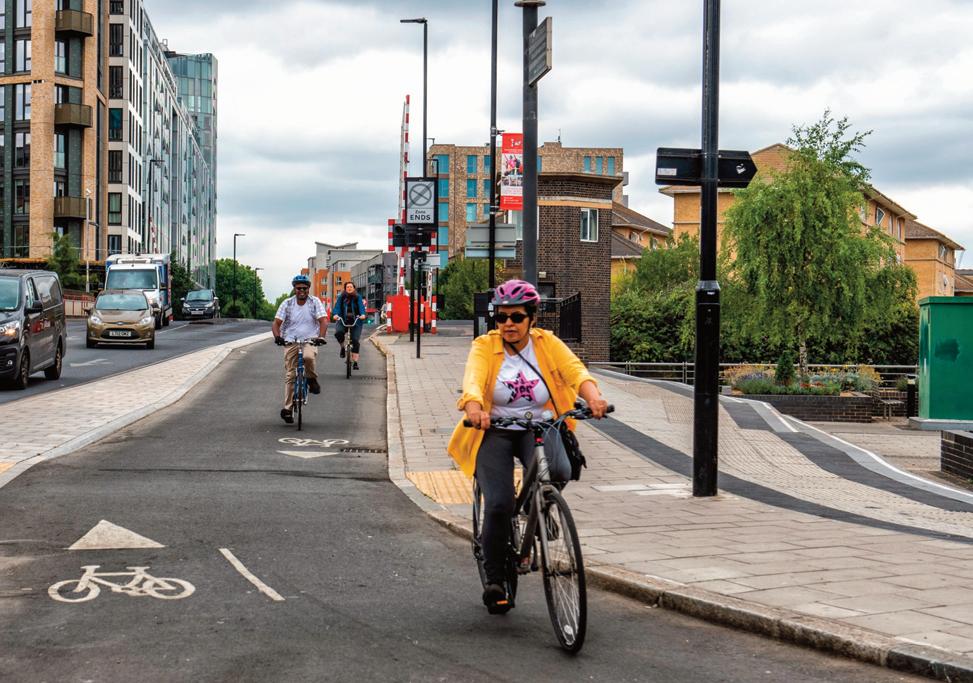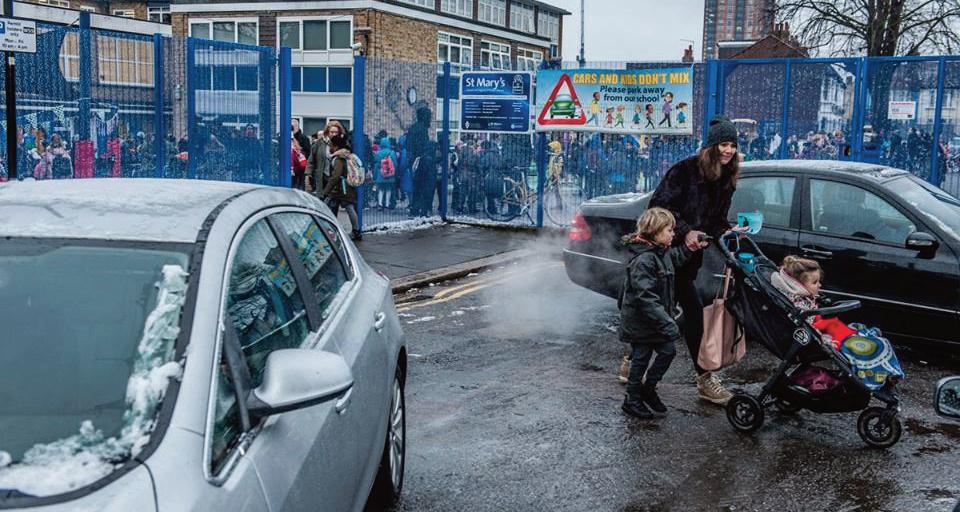
5 minute read
GREENWICH UNVEILS PLAN TO TRANSFORM STREETSCAPES
The Royal Borough of Greenwich has pledged to invest £3.1m to improve infrastructure for walking and cycling, tackle congestion and improve air quality
Greenwich’s street improvement plan, including £2.1m from TfL and £1m from the council’s own budget, will support transport priorities over the next year as identified in the council’s new Transport Strategy.
Advertisement
Priorities include: l 20mph speed limits l Controlled Parking Zones (CPZs) l More School Streets l Emissions-based parking charges l Free cycle training and a ‘try before you bike’ scheme, run with Peddle My Wheels.
The council says it will also improve public spaces in Greenwich town centre to encourage more walking and cycling, as part of the Liveable Neighbourhoods scheme. This is one of five Liveable Neighbourhoods that TfL has funded this year. The work will complement improvements to cycle routes between Greenwich and Woolwich, said the council.
Improvements are also planned on the boroughs transport network including proposals for the extension of the DLR to Thamesmead, via Beckton Riverside.
This will support new housing and improve access to jobs, said the council, adding that is working with partners including TfL, the GLA, Newham Council and local landowners to develop a business case for the project.
The council said it is considering options for traffic management measures in west and east Greenwich, “where many local residents have reported concerns about congestion, poor air quality and road safety”. Over 5,000 comments and suggestions have been received from local residents and businesses online and at two public events in the first phase of consultation undertaken in February and March, said the council.
Averil Lekau, deputy leader and cabinet member for climate change, environment and transport, said: “We’re committed to creating a world-class transport network that enables our residents, businesses and visitors to make the most of all the opportunities offered throughout Royal Greenwich – giving people access to housing, jobs, leisure, education and culture.
“How we move through our borough is also key to our long-term health and wellbeing. The easier we make it to walk, cycle and move around, the healthier we will all be. As we reduce traffic and fumes, we'll make our air cleaner to breathe too.
“All the transport projects we have in the pipeline essential to our push to become carbon neutral by 2030.” n

It’s great when a good thing catches on. School Streets, where the road outside a school is closed to traffic at drop off and pick up times, are an excellent example. First introduced to England in 2018, there are now over 500 in London, and hundreds around the rest of the country. In the world of highway authorities, that’s extremely fast-moving. Research shows that a School Street not only benefits the targeted school, but also the entire community around that school, as well as nearby local schools that may not be able to implement their own school street. For those reasons we at Mums for
Why We Need More School Streets As Quickly As Possible
More councils are recognising the benefits of School Streets. Not only do schemes cut air pollution and road danger while encouraging active travel, but are also self-funding, writes Claire
McDonald
Lungs think councils should not hesitate, and should introduce as many as possible as quickly as possible.

Impact of pollution on children
First, it might be helpful to understand the situation around many of the 24,000 plus schools in England. According to research by King's College London,1 school children are exposed to five times more air pollution on the school run than any other time. Research2 in 2021, showed that a quarter of all schools were in areas with levels of pollution higher than what the World Health Organisation deems safe. Those guidelines have since been tightened, meaning many more schools are now in areas where air pollution targets are exceeded.
In addition to this, we know that air pollution affects children more than grown ups. This is because they breathe more frequently and more deeply than adults, they are closer to the emissions, and their lungs are still developing. Research3 shows that children who grow up 50m from a main road can have lungs stunted by up to 14%.
Fortunately, School Streets go some way to mitigate these terrible statistics. Research4 shows they reduce traffic as well as air pollution by 23%5. This is obviously reason enough to campaign for them, but we believe their impact is even bigger. Why? Here are a few reasons.
The rush hour and school run
According to research6 the school run accounts for 25% of morning peak traffic. By making it difficult to drive to, or park around a school, it becomes less convenient to drive that journey and research7 shows that traffic falls on school streets and surrounding roads. This traffic reduction benefits everyone.
Parents are more able to walk or cycle to school with less traffic around, making it more likely that the whole family hits their active travel goals. A reduction in traffic outside the school means the teachers don’t have to manage the stressful mayhem of angry parents, honking horns and bewildered children - a common occurrence outside the school gates.


And residents who live around the school also benefit. Even when there is some displacement of traffic, research8 finds that it is not as significant as the original problem and can be managed.
Not all schools equal when it comes to traffic Catchment schools rely on pupils coming from nearby, and if that’s in an urban area, it is usually within easy walking distance. However, noncatchment schools - often independent or faith schools that don’t have a distance criteria - generally have higher driving rates. Department for Transport research9 from 2014 shows that the further a child travels to school, the more likely that journey is to be driven, with 75% of school journeys under a mile being walked, compared to 75% of journeys between 2-5 miles being driven.
HomeRun10 an app that measures 3.8 million school journeys a year, has data that shows that the average journey to an urban non-catchment primary school is 4.5 miles, compared with 1.2 miles of a catchment school.
Because of this, we think councils should not be reluctant to give non-catchment schools School Streets, as a reduction in driving rates and a more sustainable school run will not only benefit those schools, but also the communities and schools around them.

And it doesn’t need to cost councils…
Our new research11 shows that using Automatic Number Plate Recognition (ANPR) cameras to enforce School Streets means they self-fund before their first year is out.
From the 11 London boroughs with sufficient data to analyse, we found out that setting up a School Street with a multi-camera ANPR scheme costs on average £56,375 (around £20,000 for a singlecamera scheme) and returns £63,113 per year in penalty enforcement notices (on average). This money can be used on measures to reduce air pollution and road danger at schools that can’t implement a school street.
People love them
This is the one traffic reduction measure that is almost universally popular. According to research12 by the Mayor of London, 77% of parents and carers support School Streets being kept. Another survey13 by Transport for London said 81% of people whose school had a School Street wanted to keep it, and a survey14 by charity Sustrans found that residents on and around a School Street felt that the road was much safer with a School Street. These perceptions are overwhelmingly positive. For many people a School Street is the first time they see a low-car environment, and they find that they like it. There are more than 24,000 schools in England, so we’ve only just touched the surface of what can be done. School Streets mean less traffic, less road danger, less pollution and a better start to everyone’s day. n
Claire McDonald is schools lead at Mums for Lungs, a grassroots campaign organisation, concerned about the impact of air pollution on children’s health
1 https://www.kcl.ac.uk/news/children-exposed-to-five-times-more-air-pollution-onschool-run#:~:text=A%20new%20King's%20report%20has,other%20time%20of%2 0the%20day.
2 https://www.theguardian.com/environment/2021/jun/17/quarter-of-uk-pupilsattend-schools-where-air-pollution-is-over-who-limit#:~:text=The%20research%2 0found%20almost%208%2C000,annual%20average%20limit%20for%20PM2.
3 https://www.kcl.ac.uk/news/living-near-a-busy-road-can-stunt-childrens-lunggrowth
4 https://www.london.gov.uk/programmes-and-strategies/environment-andclimate-change/environment-publications/school-streets-air-quality-study
5 https://static1.squarespace.com/static/61d570b3a2957b5f755587d2/t/ 62cd908d3366e1182aab4125/1657639055691/SUTRANS+School+Streets+Closure+ and+Traffic+Displacement+Literature+Review+FINAL+July+2022.pdf
6 https://www.gov.uk/government/statistical-data-sets/nts06-age-gender-andmodal-breakdown
7 https://www.sustrans.org.uk/our-blog/research/all-themes/all/monitoring-theimpact-of-school-streets-safety-and-traffic-displacement
8 https://www.sustrans.org.uk/our-blog/research/all-themes/all/monitoring-theimpact-of-school-streets-safety-and-traffic-displacement
9 https://assets.publishing.service.gov.uk/government/uploads/system/ uploads/attachment_data/file/476635/travel-to-school.pdf
10 https://www.homerun-app.com
11 https://www.mumsforlungs.org/news/school-streets-camera-costs-research
12 https://www.homerun-app.com
13 https://content.tfl.gov.uk/school-streets-evaluation-report-website.pdf
14 https://www.sustrans.org.uk/our-blog/research/all-themes/all/monitoring-theimpact-of-school-streets-safety-and-traffic-displacement
Hackney is planning to add another five LTNs to the 19 schemes already in operation










